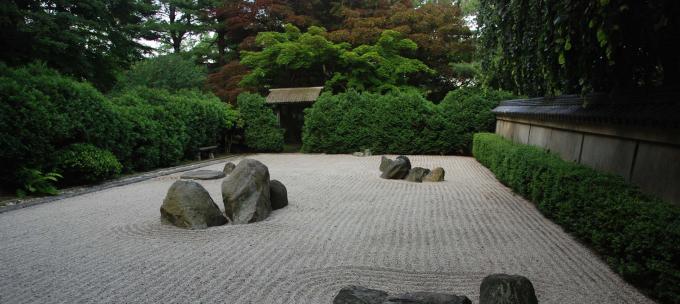

The dry landscape garden (kare-sansui), based on the fifteenth-century garden at the Zen temple Ryōan-ji in Kyoto, is designed for meditation.
Japanese Garden and Teahouse
Adapted from “The Japanese Garden at Pocantico” by Cynthia Bronson Altman, Orientations Magazine, May 2006
Located on the hillside southwest of Kykuit is a serene garden that could be in the heart of Japan. Its central feature is a brook that flows 2,200 feet, recirculates, and catches overflow from the fountains and pools of Kykuit’s gardens above. The garden was first created in 1908 by two Japanese artisans, Mr. Ueda and Mr. Takahashi, who were tasked by landscape architect William Welles Bosworth to design a hill and pond garden with a Meiji-style teahouse.
An estate road divides the garden into two sections. The lower portion, with a pond surrounded by flowering cherries, clusters of azaleas, pines and thread-leaf maples, is typical of a hill and pond garden. The upper section is more densely landscaped, and the brook and divergent paths form a stroll garden.
In the early 1960s, Nelson A. Rockefeller commissioned David Harris Engel to redesign the upper portion of the garden. Two striking features of Engel’s garden plan are a deep gorge with waterfall and the dry landscape garden (kare-sansui), based on the 15th-century garden at the Zen temple Ryōan-ji in Kyoto, designed for meditation.
The first Teahouse, completed in 1909 and now referred to as the "Shrine," is made of mahogany and originally had a thatched roof, which was replaced with copper in 1922. In 1960, the Shrine was moved west across the road to the lower section of the garden and placed in a grove of white pines. On the original site, Nelson Rockefeller commissioned a new sukiya style Teahouse with the help of his sister-in-law, Blanchette Ferry Rockefeller. This building, characterized by restrained elegance and rustic simplicity, was designed by the eminent Tokyo architect Junzō Yoshimura (1908–1997), and much of it was prefabricated in Kyoto by the firm of Nakamura Sotoji Komuten and then erected on-site by their craftsmen in 1961–62.
Tours of the Japanese Garden at Pocantico are not available through Historic Hudson Valley. Please visit the RBF’s Public Events & Performances calendar for upcoming tours.